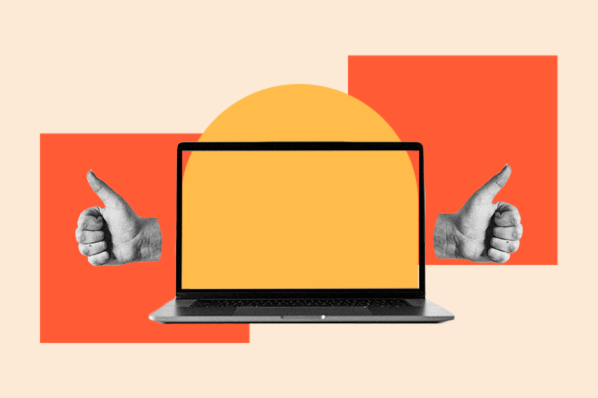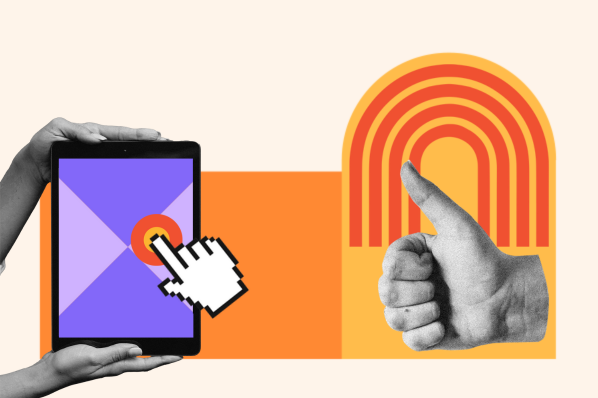Today, we'll walk you through the eye tracking process. Discover why it's useful, how it impacts usability testing, what you need to know before you get started, and how marketers can harness the power of this technology to craft websites that convert.
- What is eye tracking?
- How does eye tracking influence usability testing?
- How can you begin using eye tracking technology?
- How does eye tracking UX technology impact marketers creating websites?
- Build a Better Website Using Eye Tracking UX Technology Insights
What is eye tracking?
Eye tracking technology is a revolutionary tool that allows us to understand where people are looking, what they are focusing on, and how long their gaze lingers. By tracking eye movements, we can gain valuable insights into user behavior and preferences. When discussing eye tracking, you may come across terms like "fixation" and "saccade." Fixation refers to the points where the gaze stops, while saccade refers to the movements between fixations. By visualizing these saccades, researchers can analyze the paths our eyes take when reading a page.
Eye tracking technology, although relatively new, has its roots in the 1800s. It allows us to understand user behavior in real-time, identifying obstacles and areas for improvement. By familiarizing ourselves with the equipment and optimizing the testing setup, we can enhance websites by optimizing text, fixing stumbling points, and creating more engaging visuals. Marketers can use eye tracking insights to improve user experience and understand scanning patterns and attention-capturing elements.
When utilized effectively, eye tracking technology empowers marketers to build websites that align with user reading patterns and captivate their attention. By gaining real-time, accurate information about user perception, marketers can create a website that converts and drives user engagement.
Why is eye tracking useful?
Eye tracking is beneficial for understanding what users notice and for how long. You can harness the power of eye tracking technology to garner insights about how users absorb video, advertisements, mobile UX, packages, product shelf placement, and websites.
![]()
How does eye tracking influence usability testing?
The reason why the eye-tracking UX conversation is so prevalent is because this technology offers a highly sought-after perspective: that of the user themselves. By incorporating eye tracking UX testing technology into your company, you gain valuable insights into how people interact with your website or product in real-time. This allows you to identify any obstacles that users may encounter and troubleshoot them effectively.
Furthermore, you can effectively use eye tracking UX tech to bolster information you obtain from other testing methods. With these tangible results, you may also opt to conduct additional experimentation.
Completing eye tracking also reveals:
- Blind spots: Are users ignoring some aspects of your website? If eye tracking UX technology indicates so, you can begin strategizing how to make these more elements engaging. Once you've implemented the changes, you may conduct more eye tracking experiments to decipher if the adjustment was successful.
- Gaze patterns: Is there a specific pattern people follow when they interact with the content on your site? Are they drawn to a particular paragraph with a different font, leading them to ignore the header entirely? Noticing patterns provides insight regarding how people scan the content on your site, in what order the information gets processed, and how long it takes them to do so.
- Stumbling points: With the assistance of eye tracking UX technology, you'll discover if there are any 'stumbling points' for users interacting with your content. Yup, these are exactly what they sound like: elements that pose as trouble spots for users. They contribute to confusion or require a surplus of time to digest the information.
You can then use this behavior analysis to make informed decisions regarding your website design, copy, and beyond.
How can you begin using eye tracking UX technology?
The best part? Getting started with eye tracking for user experience testing is easier than you think. It's often as simple as connecting an eye tracker to the participant's laptop using a USB cord. However, there are a few best practices to keep in mind before conducting the testing process.
- Do your homework. Test the technology out before your participants arrive. It's beneficial to run an example test with a colleague before your participants arrive. Doing so ensures the technology is successful. You also have the opportunity to iron out any glitches before the actual occasion. Pro tip: Don't wait until 20 minutes before the experiment to test — this should be completed at least a day prior.
- Consider lighting. Provide optimal lighting, and ensure the setting is the same for all people completing the testing. Very bright lighting or intense sunlight is also unsuitable for some eye trackers.
- Make sure your technology is eyeglasses-friendly. Ensure the technology works for people who wear glasses. Not all trackers can pick up the eye motions of people who wear eyeglasses. If any of your participants do wear eyeglasses, ensure that your tracker will work regardless.
Once you test your technology, ensure optimal lighting, and guarantee that your tracker is eyeglasses friendly, you're ready to gain insight.
![]()
How does eye tracking UX technology impact marketers creating websites?
If you're a marketer, you may wonder what this all has to do with you. The answer: everything. Utilizing eye tracking UX technology allows marketers to garner a comprehensive understanding of where their website is connecting with users and where it's falling flat.
However, relying on participants to accurately recall their scanning patterns and attention patterns can be unreliable. Human memory is imperfect, and it can be challenging for individuals to accurately recount their own behaviors. Fortunately, the emergence of eye tracking technology has provided us with a solution. With real-time insights into what captures people's attention and how they perceive information, eye tracking technology allows us to gain a more accurate understanding of user behavior.
This unique perspective offered by eye tracking technology allows marketers to gain insightful knowledge into usability errors without interrupting the user's real-time behavior. This objective and accurate record enables marketers to collaborate with copywriters to enhance text where users encounter difficulties or collaborate with website designers to create visually appealing graphic elements that capture users' attention. The end result is a website that delivers an exceptional user experience.
Build a better website using eye tracking UX technology insights.
Now that you know the ins and outs of using eye tracking UX technology, you can use it to your advantage to create a website that converts. Remember: this is one of the best ways to gain accurate, real-time information regarding how users perceive your website, and it's more accessible than you'd think.
Use eye tracking wisely, and you can build a site that appeals to users' reading patterns and entices them to learn more about your company.
User Experience
.png?width=112&height=112&name=Image%20Hackathon%20%E2%80%93%20Square%20(10).png)


![How to become a UX designer, a step-by-step guide [expert tips]](https://53.fs1.hubspotusercontent-na1.net/hubfs/53/become-a-ux-designer-1-20240731-321437.webp)


![How to Add a Parallax Scrolling Effect to Your Website [Examples]](https://53.fs1.hubspotusercontent-na1.net/hubfs/53/scroll-Aug-11-2023-05-24-08-8793-PM.png)

![20 UX Design Examples Hand-Picked by Experts [With Analysis]](https://53.fs1.hubspotusercontent-na1.net/hubfs/53/ux-design-examples-1-20250404-8425368.webp)
